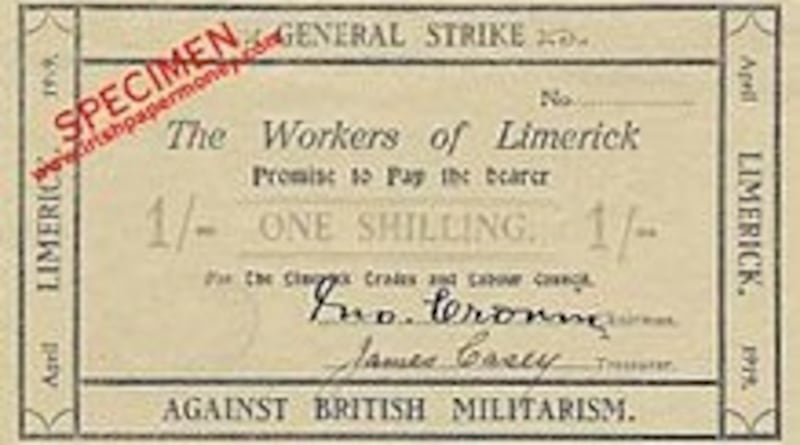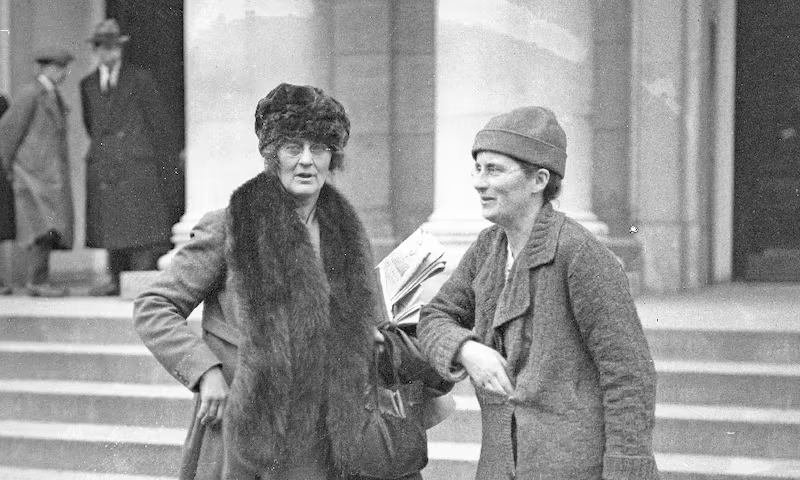"On Monday, April 14, there began in Limerick city a strike protest against military tyranny, which because of its dramatic suddenness, its completeness and the proof it offered that workers' control signifies perfect order, excited worldwide attention." – Irish Labour Party and Trade Union Congress, annual report, 1919.
'We, as organised workers, refuse to ask them for permits to earn our daily bread..." Carpenter John Cronin, leader of the strike committee and in effect the new master of the city of Limerick, spoke to journalists about their decision to close down the city.
The story of the Limerick Soviet has always had a special place in the narrative of the Irish left. For two weeks in 1919 the ordinary people of the city took over, creating, albeit briefly, the embryonic elements of workers' control – or, some would say, a new society – that mirrored developments throughout a revolutionary Europe convulsed and worn down by war. Germany and Russia led the way.


In the five weeks of the autumn of 1918 after the Germans first requested peace negotiations, half a million casualties had been added to the war’s toll. As the delegates talked, Germany continued to collapse from within: inspired by the Russian Revolution, workers and soldiers formed soviets, or councils. Bavaria proclaimed itself a socialist republic; a soviet took over in Cologne.
A year later the 15,000 striking workers of Limerick, organised by their “soviet”, the United Trades & Labour Council, would seize the city, take over the distribution of food and goods, ensure the supplies of gas, electricity and water, control transport and deliveries, and even issue their own currency.
The latter, although a crude manifestation of economic sovereignty and certainly not ideologically inspired, has been represented by socialist writers as a moment of great significance, a symbol of the emergence of an alternative state, however briefly.
Even the cinemas that opened only did so after posting the signs that became ubiquitous: “Working under authority of the strike committee.”
Although not avowedly socialist in outlook, the leadership of the strike was by no means unaware of the political significance of what they were doing. At the Limerick May Day in 1918 one speaker, RP O’Connor, claimed to applause that he supposed they would be called Bolsheviks because they extended greetings to the Russian workers, but Irishmen could claim that as a small nation they had put backbone into any part of the world they were in.
In Ireland’s decade of revolution from 1912 to 1922 the three great threads of rebellion, the national struggle, the struggle for women’s emancipation, and the flowering of the labour movement, were sometimes inextricably interwoven, at other times writing their own unique history.
Labour’s distinctive stamp on Ireland’s revolutionary history in this period was manifest most strikingly in the great battle of the 1913 lockout, the role of its Citizen Army in the Rising, the 1918 general strike against conscription, the Limerick Soviet, and the four-week 1919 Belfast engineering strike.
All were manifestations of both labour’s strengths and weaknesses – a willingness of workers to embrace militant struggle and considerable sacrifices for ends that were often far more than “mere” bread and butter; but also a deep-rooted fear in its more pragmatic leadership of “political” action that might divide the unions along sectarian lines.
Or might be anathema to trade union HQs in the rest of the UK upon whose support they would ultimately depend.
Such nervousness about “political” action was reflected in the embrace by left and right of the ideas of syndicalism in different forms, a philosophy that emphasised economic struggle as the means of empowering workers. It was also reflected in the decision in 1918 not to contest the election to allow the field free for Sinn Féin.
De Valera’s infamous injunction that “Labour must wait”, is widely blamed for the subsequent failure of the left to develop its potential.
In Limerick, all agreed, success depended on spreading the action throughout the country, but national trade union leaders, although ostensibly sympathetic to the city’s workers, found themselves unable, some say unwilling, to demand meaningful national and international solidarity.
In the end, by proposing a hopelessly impractical alternative to spreading the strike, the mass evacuation of the city, the leadership of congress made sure the soviet’s days were limited to a fortnight.
The year 1919 saw a wave of labour militancy in Ireland. There were strikes early in the year by building workers in Limerick, shipyard workers in Derry, asylum workers in Monaghan and strikes by farm labourers in counties Kildare, Meath and Tipperary – sometimes involving violent clashes with the police and non-union workers.
The announcement by the British authorities in 1918 that, in view of a shortage of men on the Western Front, conscription would be introduced in Ireland had prompted huge anger in the rank and file trade union movement.
The Irish Trade Union Congress and Labour Party had called a general strike on April 23rd in protest. It was described as "complete and entire, an unprecedented event outside the continental countries," Liam Cahill writes in his authoritative book*.
It was, he says, the first general strike in any country against measures for the more vigorous prosecution of the Great War. The Irish Times commented that the day would be "chiefly remembered as the day on which Irish labour realised its strength". Limerick participated enthusiastically.
Unions were determined to press on with their campaign and pledged to swing the entire country behind the first area where the terms of the Military Service Act and martial law was imposed. As it happened, in the face of widespread protests, the government withdrew its conscription proposals but the union plans would bear an uncanny resemblance to what would happen in Limerick.
Robert Byrne (28) was a prominent local trade unionist and member of the trades council, who had lost his job as a telegraph operator for his part in organising his colleagues in his union.
Byrne was also an active senior member of the local IRA and had been arrested and imprisoned after a courts martial for arms possession.
While in jail he led republican protests against conditions for the political prisoners. The authorities sent for RIC reinforcements who beat the prisoners. They were handcuffed, some kept in solitary, and given only bread and water.
Byrne went on hunger strike and as his condition deteriorated he ended up in Limerick Workhouse Hospital. There a group of IRA members undertook a rescue during which he was shot dead in his bed.
At the time the killing, attributed to one of the RIC guards, caused huge anger in Limerick. As Cahill reports, one of his rescuers, Michael “Batty” Stack, later one of Michael Collins’s most valued hitmen, would later admit that his gun was probably responsible, and the autopsy found that the bullet was not one fired by the RIC.
But to the people of Limerick responsibility was clear, and as protests escalated on Wednesday, April 9th, the nervous authorities imposed martial law, requiring those entering and leaving the city to produce permits.
The area proclaimed included all the city, except that part of it north of the river Shannon, with the townlands of Killalee, Monamuck, Park and Spittleland and those parts of the townlands of Rhebogue and Singland that lay to the west of the GS&WR line from Limerick to Ennis.
Two of the city's largest factories – Cleeves' Condensed Milk and Butter Company, employing 600 people (mostly women) and Walkers' Distillery – were north of the river as was the large working class area of Thomondgate. In all some 5,000 plus were cut off from their work.
On Sunday, April 13th, the trades council met for 12 hours and decided unanimously on a general strike.
It elected a strike committee, chaired by its president, John Cronin, a delegate from the Amalgamated Society of Carpenters. It set up committees to organise food and other supplies, propaganda, finance , and to preserve order. Its treasurer, printer James Casey, would sign the banknotes they would issue.
The notes, the size of an ordinary treasury note, had on their border the words: “General Strike against British Militarism 1919.” On the face was printed: “The workers of Limerick promise to pay the bearer the sum of ___ shillings.”
Speaking to reporters Cronin would put the blame for the dispute squarely on “the tragedy at the workhouse... The military authorities have seen fit to place Limerick under martial law. In doing that, they have fixed their boundaries inside the city, which makes it necessary for workers to pass in and out to their work.
“We, as organised workers, refuse to ask them for permits to earn our daily bread, and this strike is a protest against their action.”
Fortuitously for the workers, the town was crawling with representatives of the national and international press, there to report a planned first transatlantic flight by a Major JCP Wood. He hoped use Limerick as his departure point to win a £10,000 prize offered by the Daily Mail. His supporters duly cleared with the strike committee the delivery of fuel and supplies to his supposed departure point.
It was not to be. Woods ditched in the Irish Sea on his way to Limerick, but the assembled press was only to willing to report instead on what by common consent was a well-managed, overwhelmingly supported strike, free of violence.
The first, and most fundamental, task facing the strikers was that of feeding Limerick's 38,000 inhabitants. An Irish Independent headline warned of "the peril of famine".
To avoid the loss of perishable commodities, on the first day of the strike the strike committee allowed people to work at the bacon and condensed milk factories and the tanneries. Later the committee would organise a return to work in the bakeries and would issue permits to merchants to obtain and carry commodities like coal, butter and flour from the railway station to shops. From early on, the soviet claimed to have the food situation well in hand. They sat in session in the Mechanics’ Institute from early morning until late at night, and issued hundreds of permits to shops to open and supply foodstuffs, between two and five o’clock in the afternoon.
They strictly controlled the price of food and issued posters showing a list of retail prices and warning of drastic measures against profiteering. Pickets wearing distinctive badges patrolled the streets.
The currency was printed, and backed according to Tom Johnson, treasurer of the Trade Union Congress who had been sent to liaise with the strikers, by the trades council and the congress itself and accepted by approved shops.
Yet the success of the strike depended on extending it across the country. Delegates from the soviet reported widespread support and the crucial railworkers were reported to be enthusiastic. But the general secretary of the National Union of Railwaymen, Jimmy Thomas MP, sent a circular directing Irish branches to advise members “they must not take any official part in what appears to be an industrial move against political action, without the authority from the executive committee”.
The congress executive met in Limerick and proposed its alternative, the peaceful evacuation of the city. The local reaction was not good and within days as the second week of the strike progressed the trades council began to discuss a return to work by those not affected by the permits.
As Cahill writes, the congress saw an extension of the dispute as potentially revolutionary: “People like Tom Johnson might accept that Limerick was justified in calling for a national strike, but the real question was whether it was the correct strategy, knowing it would have resulted in armed revolt. Johnson believed that some day an insurrection might be developed out of labour agitation, but it should not be because of Limerick.”
On the Sunday two weeks after the strike began a strike committee resolution called for a return to work.
Four days after May Day, newspapers carried reports that the proclamation of a portion of the city of Limerick as a special military area, from April 9th, was withdrawn. Permits were no longer necessary and there was free access to the city.
The Limerick Soviet had achieved its ostensible purpose. But what might have been remains endlessly discussed.
- Liam Cahill, Forgotten Revolution: Limerick Soviet 1919, O'Brien Press, 1990
- Patrick Smyth is an Irish Times journalist




















